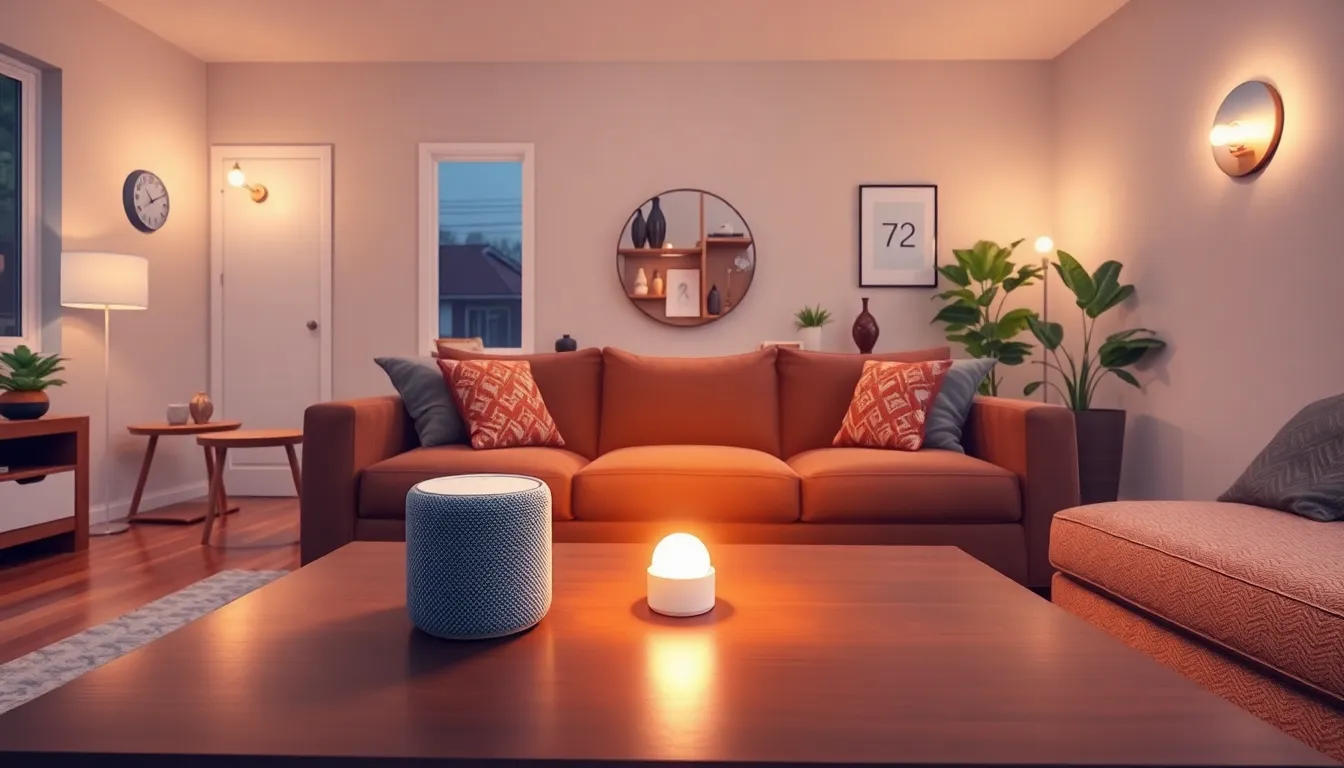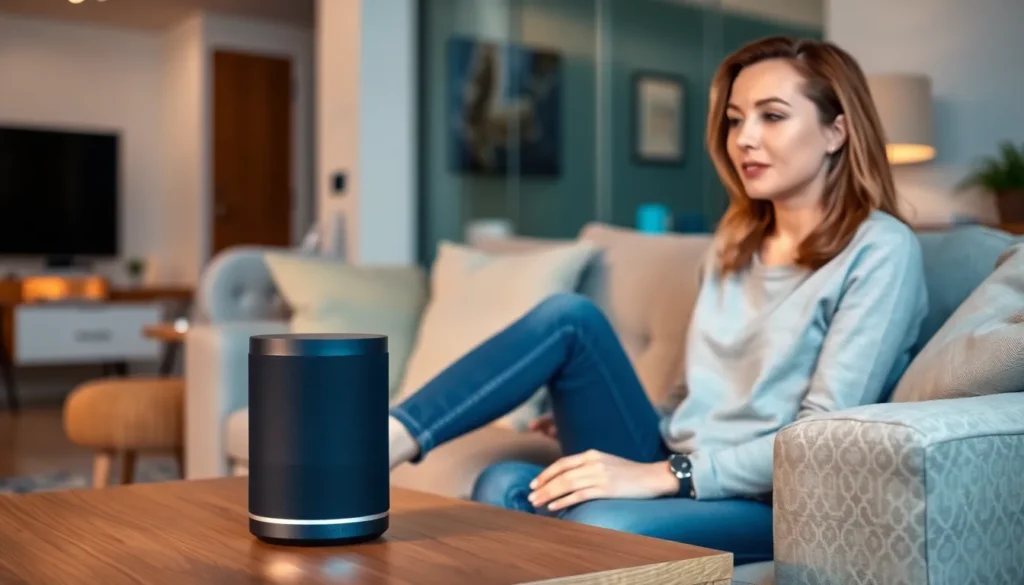Table of Contents
ToggleImagine a world where you can control your home with just your voice. No more fumbling for light switches or remote controls. With voice-operated technology, it’s like having a personal assistant who never takes a coffee break. From dimming the lights to adjusting the thermostat, this tech-savvy trend is transforming everyday living into a seamless experience.
Voice-operated homes are not just a luxury; they’re becoming essential for modern lifestyles. Picture this: you walk in after a long day, and with a simple command, your favorite playlist starts playing, the lights adjust to a cozy glow, and your dinner is already in the oven. It’s the ultimate convenience, and let’s face it, who wouldn’t want to feel like a wizard in their own castle? Embrace the future and discover how voice technology can turn a standard house into a smart, responsive home.
Overview of Voice-Operated Home Technology
Voice-operated home technology streamlines daily tasks and adds a modern touch to living environments. With devices like smart speakers and voice assistants, users can control functions such as lights, thermostats, and security systems effortlessly. Homeowners benefit from improved accessibility, making it easier for individuals with mobility challenges to manage their homes.
Integration of various smart devices enhances the user experience. Compatibility among products from different brands allows for diverse control options, facilitating a cohesive smart home ecosystem. Users often find joy in custom voice commands that bring a personal touch to device interactions.
Data indicates a substantial increase in demand for voice-operated systems. Research shows that over 50% of households in the U.S. have adopted some form of voice technology by 2022. This trend points to a shift toward more automated living spaces, with voice-activated features playing a crucial role.
Users appreciate the convenience of hands-free operation, reducing the need for physical interaction with devices. Voice commands offer a simple solution for multitasking, whether it involves playing music while cooking or adjusting temperatures without interrupting daily activities.
Developers continuously refine voice recognition, leading to improved accuracy and faster response times. Enhanced models learn from user preferences, creating a more personalized and intelligent experience. Trust in this technology grows as consumers witness its reliability and versatility in everyday situations.
Voice-operated technology signifies a pivotal advancement in creating smart homes, reflecting modern lifestyles where efficiency and ease stand at the forefront.
Benefits of Voice-Operated Home Systems

Voice-operated home systems deliver numerous advantages that enhance everyday living. They significantly improve convenience, streamline daily tasks, and promote energy efficiency.
Convenience and Accessibility
Convenience ranks high among the benefits of voice-operated systems. Smart speakers allow users to control lights, music, and appliances simply by speaking. This hands-free operation empowers users to multitask more effectively. Accessibility for individuals with mobility challenges improves with voice commands, making it easier to handle various home functions. Devices respond instantly to voice prompts, ensuring seamless interactions. The integration of smart devices creates an interconnected system that simplifies home management. Users experience a newfound sense of control over their environment, fostering a more enjoyable living space.
Energy Efficiency
Energy efficiency receives a notable boost from voice-operated technology. Smart thermostats adjust heating and cooling based on user preferences, leading to reduced energy consumption. Voice commands enable users to switch off lights in unoccupied rooms, cutting down on unnecessary energy use. Data shows that homes equipped with smart systems save an average of 15% on energy bills annually. Automation through voice-operated systems allows homeowners to monitor energy usage in real time, promoting conscious consumption. Sustainable living becomes more achievable when voice-operated systems efficiently manage household energy demands.
Popular Voice-Operated Home Devices
Voice-operated home devices enhance everyday convenience and improve the living experience. Let’s explore some of the most popular options available.
Smart Speakers
Smart speakers serve as central hubs in many smart homes. Users can play music, set reminders, or control other smart devices with simple voice commands. Leading brands include Amazon Echo and Google Nest, offering advanced features like multi-room audio and integration with various smart home ecosystems. As of 2022, over 50% of U.S. households utilized smart speakers, reflecting their rapid adoption. These devices communicate seamlessly with home automation systems, making it easy to adjust lighting and thermostats. Smart speakers not only entertain but also improve accessibility for all users.
Smart Assistants
Smart assistants revolutionize how individuals interact with technology at home. Devices like Amazon Alexa and Google Assistant respond to inquiries, provide real-time information, and execute tasks. Voice recognition technology improves constantly, ensuring faster and more accurate responses. This technology connects seamlessly with various smart devices, allowing users to control everything from security systems to home appliances. Data show that a growing number of users rely on smart assistants for daily tasks, enhancing productivity and convenience. Smart assistants empower homeowners to create a truly integrated smart home experience.
Installation and Setup Considerations
Successful installation and setup of voice-operated home systems involves several critical factors that ensure optimal functionality and user satisfaction.
Compatibility with Existing Systems
Consideration of compatibility with existing systems proves essential. Many voice-operated devices interact seamlessly with a variety of smart appliances, lights, and thermostats. Users benefit from devices that support protocols like Zigbee and Z-Wave. Third-party integrations enhance the functionality of smart speakers, such as Amazon Echo and Google Nest. Ensuring that devices work together reduces hassles during setup. Review product specifications before purchasing to confirm compatibility with current home technology. This planning leads to a smoother user experience.
Network Requirements
Network requirements play a crucial role in setup success. Strong Wi-Fi connections support the efficient operation of voice-controlled devices. Dual-band routers can improve performance by separating traffic on 2.4GHz and 5GHz bands. Users should place routers in central locations to maximize coverage throughout the home. Consideration of bandwidth is also important, especially with multiple devices connected. A speed of at least 25 Mbps is advisable for optimal performance. Regular firmware updates for routers maintain security and efficiency, enhancing the overall functioning of voice-operated systems.
Challenges and Limitations
Voice-operated home technology presents notable challenges and limitations that users must consider. Privacy concerns arise as smart devices continuously listen for voice commands. Data security remains critical, with vulnerabilities potentially exposing personal information to unauthorized access. Compatibility issues can hinder seamless integration among devices from different manufacturers, affecting user experience.
Dependence on internet connectivity poses another challenge. Users experience disruptions when internet service is slow or unavailable, rendering devices unresponsive. Voice recognition technology, while improving, can still struggle with accents or background noise, leading to frustration. Misunderstandings in commands may result in incorrect actions, reducing efficiency.
Costs associated with establishing a fully integrated voice-operated home may deter some users. Smart device prices vary widely, and ongoing expenses for energy or maintenance can accumulate. Additionally, users may require technical knowledge for installation and setup, challenging those less familiar with technology.
Limited features also hinder some voice-operated systems. Not all devices support advanced functions, restricting users to basic tasks. Smart assistants may lack the capability to control specific devices or execute complex commands, reducing overall functionality.
User fatigue can set in from constant reliance on voice commands. Over time, expectations around efficiency can lead to disappointment if devices do not meet demands consistently. Furthermore, reliance on a single input method may diminish users’ ability to engage with devices through traditional interfaces.
Awareness of these challenges helps users make informed decisions about adopting voice-operated home technology. Identifying potential limitations ensures they approach smart home integration with realistic expectations.
Voice-operated home technology is reshaping how individuals interact with their living spaces. With its growing popularity and significant benefits, it’s clear that this innovation is here to stay. As more households embrace smart devices, the convenience and efficiency they offer will only enhance daily life.
While challenges like privacy concerns and compatibility issues exist, the advantages often outweigh the drawbacks. By staying informed about the latest developments and best practices, homeowners can fully leverage this technology. Embracing voice-operated systems not only streamlines tasks but also creates a more connected and enjoyable home environment.




